This past summer, I hired three undergraduate research students to join my research team. Each worked on an independent research project that culminated in the submission of an abstract to a major conference. We were notified in November that all three students’ abstracts were accepted, two as poster presentations and one was selected as a podium presentation. Additionally, all of my research students applied and were awarded Montana INBRE Travel Grants to aid in funding their travel to this conference. Thus, on February 8-11, my research team traveled to Phoenix, AZ, to attend the Orthopedic Research Society (ORS) Annual Meeting and present our research.
ORS is an international conference (with over 3,000 members) for biologists, engineers, surgeon-scientists, orthopedic surgeons, and those in the field of musculoskeletal science and orthopedic care. Thousands of leading experts in orthopedics attend from across all across the world. Importantly, Carroll College was the smallest higher education institution represented (by a landslide), and the ONLY research team composed of exclusively undergraduates. Every other research team in attendance was composed of a combination of PhDs, MDs, DVMs, post-doctoral researchers, and graduate and undergraduate students.
Hope Welhaven, a senior health science/public health major, was selected as one of three individuals (out of THOUSANDS of attendees) to give an oral podium presentation during an Osteoarthritis Phenotypes Spotlight Session. Her talk was titled, “Metabolomic profiles of articular cartilage vary by osteoarthritis grade.” Ethan Viles and Jenna Starke were selected for poster presentations. Ethan, a junior biology major, presented one of his summer projects titled, “Metabolomic profiles of conditioned media from primary human osteoarthritic chondrocytes and SW1353 cells.” Jenna Starke, a recent Carroll graduate and soon-to-be medical student presented her work titled, “Global metabolomic profiles of human joint fluid following a second ACL tear: a case study.”
